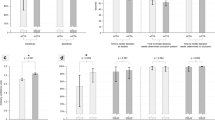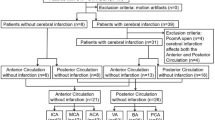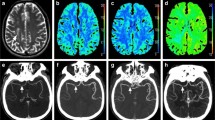Abstract
Objective
To describe and evaluate a novel technical development to improve detection of intracranial vessel occlusions using multiphase CT angiography (MPCTA).
Materials and methods
The institutional ethics committee approved the study. Fifty patients (30 consecutive distal (M2 or smaller) anterior circulation occlusions, ten M1 occlusions, ten cases without occlusion) presenting with suspected AIS who underwent MPCTA were included. Post-processing of MPCTA studies created “subtraction” and “delayed enhancement” (DE) datasets. Initially, non-contrast CT and MPCTA studies for each patient were evaluated. Readers' confidence, speed and sensitivity of detection of intracranial vessel occlusions were recorded. After an interval of at least 4 weeks, readers were provided with post-processed images and studies were re-evaluated.
Results
While the sensitivity of detection of intracranial vessel occlusions was equal for both conventional MPCTA and subMPCTA, the mean time taken to identify a vessel occlusion decreased by 64 % using subMPCTA (16 s vs. 45 s with conventional MPCTA) (p<0.001). In addition, confidence in interpretation improved (from 4.4 to 4.9) using subMPCTA (p<0.001).
Conclusion
SubMPCTA is a novel technique that aids in identifying small intracranial vessel occlusions in the suspected AIS patient. SubMPCTA increases confidence in interpretation and reduces the time taken to detect intracranial vessel occlusions.
Key Points
• SubMPCTA processes MPCTA data to better demonstrate intracranial arterial occlusions.
• SubMPCTA increases confidence and speed of interpretation of MPCTA studies.
• SubMPCTA may aid in rapidly differentiating acute ischaemic stroke from stroke mimics.






Similar content being viewed by others
Abbreviations
- A2:
-
Second segment of the anterior cerebral artery
- A3:
-
Third segment of the anterior cerebral artery
- ACA:
-
Anterior cerebral artery
- AICA:
-
Anterior inferior cerebellar artery
- AIS:
-
Acute ischaemic stroke
- CT:
-
Computed tomography
- DSA:
-
Digital subtraction angiography
- ICA:
-
Internal carotid artery
- IVO:
-
Intracranial vessel occlusion
- M1:
-
First segment of the middle cerebral artery
- M2:
-
Second segment of the middle cerebral artery
- M3:
-
Third segment of the middle cerebral artery
- MCA:
-
Middle cerebral artery
- MIP:
-
Maximum intensity projection
- MPCTA:
-
Multiphase computed tomographic angiography
- MRI:
-
Magnetic resonance imaging
- NCCT:
-
Non-contrast computed tomography
- NIHSS:
-
National Institute of Health Stroke Scale
- NPV:
-
Negative predictive value
- PACS:
-
Picture Archiving and Communicating Systems
- PICA:
-
Posterior inferior cerebellar artery
- PPV:
-
Positive predictive value
- SCA:
-
Superior cerebellar artery
- SPCTA:
-
Single-phase computed tomographic angiography
References
Menon BK, d'Esterre CD, Qazi EM et al (2015) Multiphase CT Angiography: A New Tool for the Imaging Triage of Patients with Acute Ischemic Stroke. Radiology 275:510–520
Bang OY, Goyal M, Liebeskind DS (2015) Collateral Circulation in Ischemic Stroke: Assessment Tools and Therapeutic Strategies. Stroke 46:3302–3309
Kucinski T, Koch C, Eckert B et al (2003) Collateral circulation is an independent radiological predictor of outcome after thrombolysis in acute ischaemic stroke. Neuroradiology 45:11–18
Byrne D, Sugrue G, Stanley E et al (2017) Improved Detection of Anterior Circulation Occlusions: The "Delayed Vessel Sign" on Multiphase CT Angiography. AJNR Am J Neuroradiol. https://doi.org/10.3174/ajnr.A5317
Wahlgren N, Moreira T, Michel P et al (2016) Mechanical thrombectomy in acute ischemic stroke: Consensus statement by ESO-Karolinska Stroke Update 2014/2015, supported by ESO, ESMINT, ESNR and EAN. Int J Stroke 11:134–147
Laurencin C, Philippeau F, Blanc-Lasserre K et al (2015) Thrombolysis for Acute Minor Stroke: Outcome and Barriers to Management. Results from the RESUVAL Stroke Network. Cerebrovasc Dis 40:3–9
Greisenegger S, Seyfang L, Kiechl S, Lang W, Ferrari J (2014) Thrombolysis in patients with mild stroke: results from the Austrian Stroke Unit Registry. Stroke 45:765–769
Rha JH, Saver JL (2007) The impact of recanalization on ischemic stroke outcome: a meta-analysis. Stroke 38:967–973
Menon BK, Qazi E, Nambiar V et al (2015) Differential Effect of Baseline Computed Tomographic Angiography Collaterals on Clinical Outcome in Patients Enrolled in the Interventional Management of Stroke III Trial. Stroke 46:1239–1244
d'Esterre CD, Trivedi A, Pordeli P et al (2017) Regional Comparison of Multiphase Computed Tomographic Angiography and Computed Tomographic Perfusion for Prediction of Tissue Fate in Ischemic Stroke. Stroke 48:939–945
Volny O, Cimflova P, Kadlecova P et al (2016) Single-Phase Versus Multiphase CT Angiography in Middle Cerebral Artery Clot Detection-Benefits for Less Experienced Radiologists and Neurologists. J Stroke Cerebrovasc Dis. https://doi.org/10.1016/j.jstrokecerebrovasdis.2016.08.023
Yu AY, Zerna C, Assis Z et al (2016) Multiphase CT angiography increases detection of anterior circulation intracranial occlusion. Neurology. https://doi.org/10.1212/wnl.0000000000002951
Kamal N, Hill MD, Blacquiere DP et al (2015) Rapid Assessment and Treatment of Transient Ischemic Attacks and Minor Stroke in Canadian Emergency Departments: Time for a Paradigm Shift. Stroke 46:2987–2990
Poletti PA, Rosset A, Didier D et al (2004) Subtraction CT angiography of the lower limbs: a new technique for the evaluation of acute arterial occlusion. AJR Am J Roentgenol 183:1445–1448
Tomandl BF, Hammen T, Klotz E, Ditt H, Stemper B, Lell M (2006) Bone-subtraction CT angiography for the evaluation of intracranial aneurysms. AJNR Am J Neuroradiol 27:55–59
Jovin TG, Saver JL, Ribo M et al (2017) Diffusion-weighted imaging or computerized tomography perfusion assessment with clinical mismatch in the triage of wake up and late presenting strokes undergoing neurointervention with Trevo (DAWN) trial methods. Int J Stroke 12:641–652
Demchuk AM, Menon BK, Goyal M (2016) Comparing Vessel Imaging: Noncontrast Computed Tomography/Computed Tomographic Angiography Should Be the New Minimum Standard in Acute Disabling Stroke. Stroke 47:273-281
Djulejic V, Marinkovic S, Georgievski B et al (2016) Clinical significance of blood supply to the internal capsule and basal ganglia. J Clin Neurosci 25:19–26
Touaoussa A, El Youssi H, El Hassani I et al (2015) Disseminated intravascular coagulation: clinical and biological diagnosis. Ann Biol Clin (Paris) 73:657–663
Acknowledgements
We would like to acknowledge the assistance provided by Jonathan Siung in this project.
Author information
Authors and Affiliations
Corresponding author
Ethics declarations
Guarantor
The scientific guarantor of this publication is Dr Peter MacMahon.
Conflict of interest
The authors of this manuscript declare no relationships with any companies whose products or services may be related to the subject matter of the article.
Funding
The authors state that this work has not received any funding.
Statistics and biometry
One of the authors has significant statistical expertise.
Informed consent
Written informed consent was waived by the Institutional Review Board.
Ethical approval
Institutional Review Board approval was obtained.
Study subjects or cohorts overlap
Some study subjects or cohorts have been previously reported in American Journal of Radiology (AJNR), October 2017 “Improved Detection of Anterior Circulation Occlusions: The Delayed Vessel Sign on Multiphase CT Angiography”.
Methodology
• retrospective
• diagnostic or prognostic study
• performed at one institution
Rights and permissions
About this article
Cite this article
Byrne, D., Walsh, J.P., Sugrue, G. et al. Subtraction multiphase CT angiography: A new technique for faster detection of intracranial arterial occlusions. Eur Radiol 28, 1731–1738 (2018). https://doi.org/10.1007/s00330-017-5124-1
Received:
Revised:
Accepted:
Published:
Issue Date:
DOI: https://doi.org/10.1007/s00330-017-5124-1




